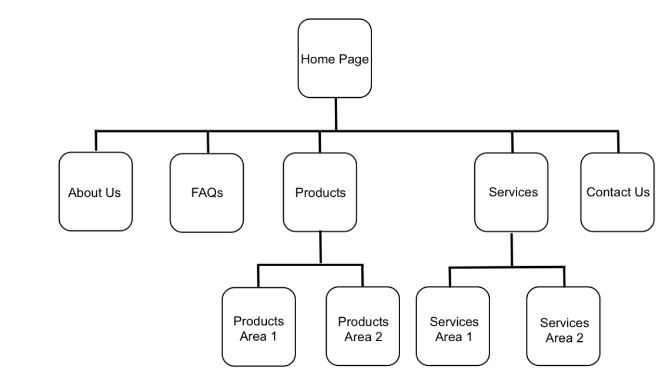
Every website has its own URL architecture, but not all websites are structured in the most optimal way for search engines. A properly structured website will also make it easier for the user to navigate from the homepage to the specific section that they’re interested in, often in just a few clicks. How ‘deep’ this webpage architecture goes is dependent on the type and size of the site.
Optimising your website’s structure and architecture goes far beyond having an organised layout for your current business. Good website structure is intricately connected to SEO, keyword research and will allow your site to scale and diversify whilst all the time maintaining a tight and intuitive structure. In this guide, I want to look at some of the hard and fast rules about website architecture.
How Website Structure and Architecture Affect Your Google Rankings
Increased readability for search crawlers
Google uses an algorithm to identify your website and assess how relevant it is. One of the ways it does this is to crawl your webpages by following on-page links to other pages on your site. These website crawlers rely significantly on the structure of your website when figuring out what to show in search pages. A clear website structure allows Google and other search engines to better assign relevancy to a given set of pages. This is often achieved by siloing content on a site by topic, product type or service type (we’ll explore this more later on).
More engaged users
Your website structure determines how users can go from one webpage to another. Websites often hold a lot of information, so the more organised and logical the structure is, the more efficiently visitors can find what they’re looking for. And the better someone can find what they’re looking for the more engaged they are likely to be and the longer they’re likely to stay on your site. Because Google looks at user metrics such as dwell time and bounce rate (the percentage of users who leave a webpage without clicking through to any other pages), this not only gives them a positive impression of your website, but will actually help your website rank.
Creating a Website Structure
First, make sure that you have a good understanding of your target audience. What would they be looking for when they turn to your website? Keyword research is essential because this will tell you which keywords your target audience is searching for on Google to find your competitors, allowing you to incorporate these into your website layout and content.
You can then move on to designing your website structure and architecture, which is typically shown as a flowchart (see image below). Websites will usually have a homepage, with the rest of their pages organised into categories and subcategories. Depending on the number of products or services these should be part of a specific category, with each individual product or service sitting underneath this as child pages. Aim for seven or less categories displayed on the main menu of your homepage. If you have a lot of webpages, you can divide each category into further subcategories (an example of this might be a Newspaper site which has a category page called ‘Culture’ which could be further divided into sub categories like ‘Film’, ‘Theatre’, ‘Music’, ‘Art’ and ‘Television’.)
Source: Ya-web design
As much as possible, keep the categories balanced so there’s a roughly equal number of pages under each. Ultimately, your website should feel intuitive to navigate, and the structure should make sense for the user. Unless you have an ecommerce site and a very large number of products to offer it’s best to go for a ‘shallow website structure’ where users will have to do four clicks at most to get to a certain page, so don’t make any of the pages too nested.
URL Structure
Once your website structure and architecture are in place, you can decide on your URL structure. The URL of a page is its web address, and even this has to be clear and SEO-friendly. Here’s a common URL structure that draws from your overall website structure:
www.example.com/category/subcategory/product-name
The URL structure must be consistent for all your webpages. You also have to incorporate keywords while keeping the URL human-readable. The limit is 512 pixels so choose a concise URL without unnecessary words, and be mindful too of case sensitivity.
Content Siloing
Keyword research is essential to effective website structure as it will help you identify individual topics that will form the top level of your URL architecture. This is the basis of what we call content siloing where related content, whether it be sub service pages, cornerstone content, blog articles, landing pages, offers, whitepapers, downloadable media, etc all sits under the same top level URL. Some CMS’s enforce their own URL structure making it much harder to silo content (WordPress is amongst the most flexible and easiest CMS to silo content).
So let’s say you run an online pet accessories shop and you have a product category called dog-accessories and you write a blog article about what to look for in the perfect dog lead. Instead of that blog post having a URL ending /blog/tips-for-choosing-dog-leads in a siloed site that URL would end dog-accessories/tips-for-choosing-dog-leads. Google now sees that content as sitting underneath the topic of dog accessories along with all your other product pages. This is an incredibly powerful SEO technique and one that requires site structure to be understood and mapped out from the initial website build onwards.
Cornerstone Content
Cornerstone content refers to the most important pieces of content on your website that you want viewers to see. While these are typically part of your website’s blog, it’s also advisable to have at least one outside your blog that’s clickable from the homepage. In general, content for each page should be high-quality, so buff up any pages that are light in content or merge them together.
Internal Linking
Internal linking is at the heart of your website structure and architecture. This happens when one webpage within your website links to another, effectively pouring SEO authority from the original page to another and enticing visitors to stay on your website. You should aim to give every webpage an internal link, and it also has to be linked to by another page. This makes your website more connected, which helps with search engine processing. You can also select cornerstone content and link to it more often throughout your website.
Linking must be incorporated naturally into the page, blending in with the rest of the content. You can have the link as a menu option, as with the categories on your homepage, or make it part of the page body. The anchor text (or the text in the link) should be relevant because search engines will check that to figure out what you’re linking to. As a rule, blog posts and cornerstone content that sits under a service or product category should try to link upwards to that parent page.
Tips for Ecommerce Sites
Good website structure is of vital importance to Ecommerce websites. Categories are emphasised here because they’ll lead to your product, and pages that list products must have pagination to make them more convenient for users. With organised categories, removing or updating products will be much simpler.
While your product pages must still have internal linking, don’t put too many links in the product descriptions because this can distract your customer away from buying the product and can actually cause confusion within your site architecture. Instead, opt for separated links that show up as recommendations or similar items below the product. You can do the usual internal linking on your online shop’s blog and cornerstone content instead. It’s also ok to internally link in category pages to other category pages if there is relevance.
Your SEO Strategy Starts with Your Website Structure and Architecture
Of course, SEO is just one aspect of your digital marketing strategy. Ecommerce sites have always relied on a range of other digital channels to bring in new business for example (as this illuminating article from Shopify on email marketing shows, the scale at which some of the big players do this is massive). That being said, if you’re running an ecommerce site, then optimising that site is absolutely critical to your ongoing success and this all starts with good site architecture.
Even email marketing campaigns will rely on an easily navigable site, and subscribers are likely to purchase more if they can navigate well and are shown related products through internal linking.
Your website is so foundational because so many other marketing channels are simply directing people to your website. Good website structure will have a huge impact on your organic traffic, but it will also force you to think about user experience and - more fundamentally - how your business offering is broken down by service or product area.
About the Author
Joe Cox is Content Director at Bristol based digital marketing agency, Superb Digital.
- Log in to post comments

